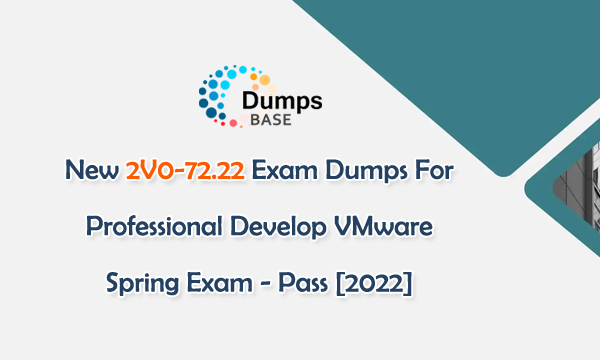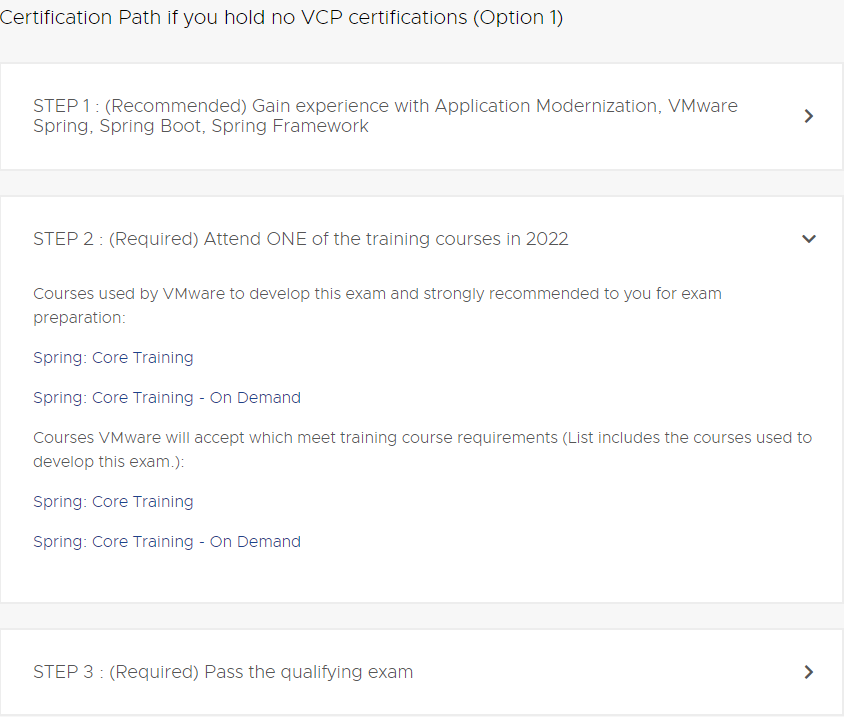New 2V0-72.22 Exam Dumps For Professional Develop VMware Spring Exam - Pass [2022]
If you are really intended to pass 2V0-72.22 Professional Develop VMware Spring exam and be a VCP-AM Develop certification, you will be recommended to choose new 2V0-72.22 exam dumps of DumpsBase as the preparation materials. As the best platform, DumpsBase offers new and valid VMware certification 2V0-72.22 exam dumps with actual questions and precise answers for Professional Develop VMware Spring Certification exam duly prepared by experts. VMware 2V0-72.22 dumps questions are based on the real exam objectives, all the knowledge you will grab from DumpsBase 2V0-72.22 exam dumps. DumpsBase is dedicated to your accomplishment, hence assures you success in 2V0-72.22 Professional Develop VMware Spring exam on the first try.

Exam 2V0-72.22 Professional Develop VMware Spring Overviews
New 2V0-72.22 exam dumps of DumpsBase the best to ensure your success. However, before getting the online resource to prepare for actual VMware certification 2V0-72.22 exam well, you need to read all the 2V0-72.22 exam overviews clearly. VMware 2V0-72.22 exam is a hot test, containing 60 questions, which is required to answer completely in 130 minutes. It tests your expertise with major features of Spring and Spring Boot and the ability to apply Spring's features to quickly build and deliver production ready applications.
2V0-72.22 exam is the requirement of VMware Certified Professional - Application Modernization Develop 2022 (VCP-AM Develop 2022) certification. When planning for VCP-AM Develop 2022 certification, you need to choose the correct path to complete.
Path 1: If you hold no VCP certifications, you have two options to complete VCP-AM Develop 2022 certification.
Option 1: It is recommended to gain experience with Application Modernization, VMware Spring, Spring Boot, Spring Framework, then attend one of the training courses in 2022. Finally, pass Professional Develop VMware Spring (2V0-72.22) exam successfully.

Option 2: It is recommended to gain experience with Application Modernization, VMware Spring, Spring Boot, Spring Framework, then pass VMware Spring Professional (EDU-1202) exam.
Path 2: If you hold a VCP-Spring 2020 or Newer, you are recommended to gain experience with Application Modernization, VMware Spring, Spring Boot, Spring Framework, then attend ONE of the training courses in 2022, finally, pass Professional Develop VMware Spring (2V0-72.22) exam successfully.
New 2V0-72.22 Exam Dumps Are Based On Real 2V0-72.22 Exam Objectives
New 2V0-72.22 exam dumps have been verified by the experts, who written the actual dumps questions and answers based on the real 2V0-72.22 exam objectives. VMware 2V0-72.22 exam dumps cover each topic of real Professional Develop VMware Spring (2V0-72.22) exam as follows:
Section 1 – Spring Core
Section 2 – Data Management
Section 3 – Spring MVC
Section 4 – Testing
Section 5 – Security
Section 6 – Spring Boot
We have received comments from thousands of candidates who have successfully achieved Professional Develop VMware Spring certification only because of authentic and true VMware 2V0-72.22 exam dumps. If you're seeking to be successful in a profession, select Professional Develop VMware Spring 2V0-72.22 dumps of DumpsBase for successful future success. To check 2V0-72.22 dumps questions first, you can read VMware 2V0-72.22 free dumps first.
Below are 2V0-72.22 free dumps for reading:
Which two statements are true regarding Spring Boot Testing? (Choose two.)
A. @TestApplicationContext is used to define additional beans or customizations for a test.
B. Test methods in a @SpringBootTest class are transactional by default.
C. @SpringBootTest is typically used for integration testing.
D. Test methods annotated with @SpringBootTest will recreate the ApplicationContext.
E. @SpringBootTest without any configuration classes expects there is only one class annotated with@SpringBootConfiguration in the application.
Answer: C,D
Which two use cases can be addressed by the method level security annotation @PreAuthorize? (Choose two.)
A. Allow access to a method based on user identity.
B. Allow access to a method based on the returned object.
C. Allow access to a method based on HTTP method.
D. Allow access to a method based on request URL.
E. Allow access to a method based on roles.
Answer: C,E
Which two statements are true regarding a Spring Boot-based Spring MVC application? (Choose two.)
A. The default embedded servlet container can be replaced with Undertow.
B. Jetty is the default servlet container.
C. Spring Boot starts up an embedded servlet container by default.
D. The default port of the embedded servlet container is 8088.
E. Spring MVC starts up an in-memory database by default.
Answer: B,C
What are the two reasons Spring be used to build a Java application? (Choose two.)
A. Spring automates a Java application build.
B. Spring provides a Dependency Injection container.
C. Spring automates deployment of Java applications to all of the major cloud providers.
D. Spring provides comprehensive Java IDE support.
E. Spring provides abstractions over infrastructure such as persistence and messaging.
Answer: A,B
Which two statements are correct regarding the @EnableAutoConfiguration annotation? (Choose two.)
A. It is a meta-annotation on the @SpringBootApplication composed annotation.
B. It enables auto-configuration of the ApplicationContext by attempting to guess necessary beans.
C. It is meta-annotation on the @SpringBootConfiguration composed annotation.
D. It has the same effect regardless of the package of the class that is annotated with it.
E. It ensures auto-configuration is applied before user-defined beans have been registered.
Answer: A,D
Which two are required to use transactions in Spring? (Choose two.)
A. Add @EnableTransactionManagement to a Java configuration class.
B. Annotate a class, an interface, or individual methods requiring a transaction with the @Transactional annotation.
C. A class must be annotated with @Service and @Transaction.
D. A class requiring a transaction must implement the TransactionInterceptor interface.
E. Write a Spring AOP advice to implement transactional behavior.
Answer: A,B
Which two statements are true regarding bean creation? (Choose two.)
A. A Spring bean can be explicitly created by annotating methods or fields by @Autowired.
B. A Spring bean can be implicitly created by annotating the class with @Component and using the component-scanner to scan its package.
C. A Spring bean can be implicitly created by annotating the class with @Bean and using the component- scanner to scan its package.
D. A Spring bean can be explicitly created using @Bean annotated methods within a Spring configuration class.
E. A Spring bean can be explicitly created by annotating the class with @Autowired.
Answer: B,E
Which statement defines a pointcut? (Choose the best answer.)
A. A point in the execution of a program such as a method call or field assignment.
B. An expression that selects one or more join points.
C. A module that encapsulated advices.
D. Code to be executed at each selected join point.
Answer: B
Which two statements are correct regarding the Health Indicator status? (Choose two.)
A. The last status in a sorted list of HealthIndicators is used to derive the final system health.
B. The status with the least severity is used as the top-level status.
C. Custom status values can be created.
D. The built-in status values are DOWN, OUT_OF_SERVICE, UNKNOWN, and UP in decreasing order of severity.
E. The severity order cannot be changed due to security reasons.
Answer: C,D
What is a Spring Boot starter dependency? (Choose the best answer.)
A. A setting for specifying which code you want Spring Boot to generate for you.
B. A specific POM which you must build to control Spring Boot’s opinionated runtime.
C. A pre-existing model project you can download and use as the basis of your project.
D. An easy way to include multiple, coordinated dependencies related to a specific technology, like web or JDBC.
Answer: D
